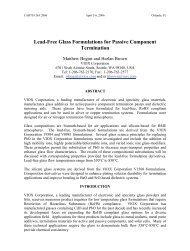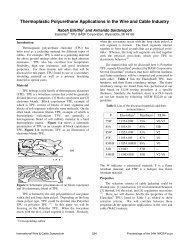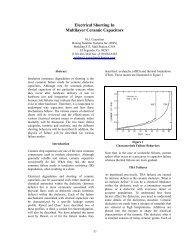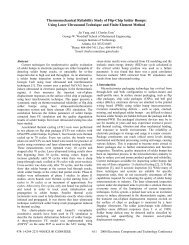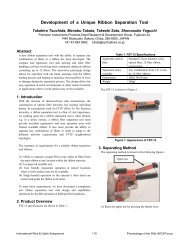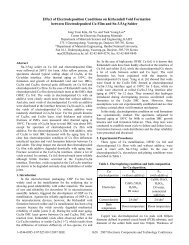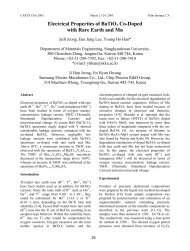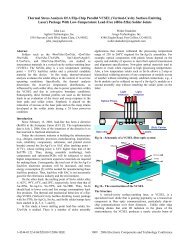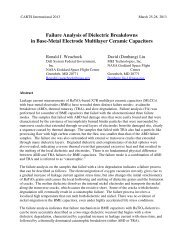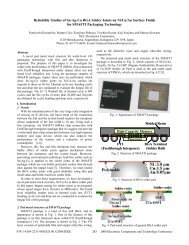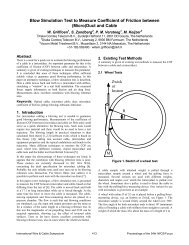Evaluation of Differential and Common - Mode Transmission ...
Evaluation of Differential and Common - Mode Transmission ...
Evaluation of Differential and Common - Mode Transmission ...
- No tags were found...
Create successful ePaper yourself
Turn your PDF publications into a flip-book with our unique Google optimized e-Paper software.
<strong>Evaluation</strong> <strong>of</strong> <strong>Differential</strong> <strong>and</strong> <strong>Common</strong> - <strong>Mode</strong> <strong>Transmission</strong> Through UTPCables Using FE TechniquesS. Dorai 1 , W. Yin 1 , J. Kelly 2 <strong>and</strong> A. J. Peyton 11School <strong>of</strong> Electrical <strong>and</strong> Electronic Engineering, The University <strong>of</strong> Manchester, Manchester, M60 1QD2 Middlegate, White Lund Industrial Estate, Morecambe, LA3 3BN, U.K+44-161-306-2870 · Sriram.dorai@postgrad.manchester.ac.ukAbstractThe purpose <strong>of</strong> this paper is to demonstrate a methodology forpredicting the amount <strong>of</strong> energy propagating differentially <strong>and</strong> incommon mode for a UTP (Unshielded twisted pair) cable using FE(Finite element) techniques. Several cases are considered, such as aproperly terminated line with no source or load impedancemismatch <strong>and</strong> other combinations <strong>of</strong> improperly terminated lines.Consequently, the relative signal strength <strong>of</strong> the differential <strong>and</strong>common mode components <strong>of</strong> the transmitted <strong>and</strong> reflected signalscan be determined in the form <strong>of</strong> voltage versus distance versus timematrix, which is plotted to show the full evolution <strong>of</strong> energy transferalong the cable versus time.Keywords: <strong>Differential</strong> <strong>and</strong> common mode signals, UTP cables,Finite element techniques, wall <strong>and</strong> patch panel connectors.1. IntroductionTwisted pair cables use differential mode <strong>of</strong> transmission to reduceradiation losses <strong>and</strong> also to be immune to noise from the externalenvironment since the impedance <strong>of</strong> each conductor with referenceto ground remains the same. This is based on the fact that bothinsulated conductors in a pair are similar enough to cancel emission<strong>and</strong> radiation noises into <strong>and</strong> from the environment. In a real twistedpair, there always exists differences between the conductors hencenoise cancellation is not absolute. This lack <strong>of</strong> balance can cause thedifferential mode signals to convert into common mode <strong>and</strong> if notcancelled by common mode chokes or differential receivers, thesecommon mode signals will remain in the system as a potential form<strong>of</strong> crosstalk.It would be helpful to cable <strong>and</strong> system manufacturers if they couldtake these factors into account during the design stages. In thispaper, a method <strong>of</strong> obtaining the differential <strong>and</strong> common modevoltages for all pairs in a UTP cable is presented using combinedfinite element <strong>and</strong> circuit analysis technique.2. Analysis methodIn order to analyze the performance <strong>of</strong> a twisted pair cable, we firstneed to extract the per unit length RLC matrix consisting <strong>of</strong> allcombinations <strong>of</strong> capacitances, inductances <strong>and</strong> the mutual couplingsthat exist between the pairs. Since these per unit length primaryparameters have strong dependence on the geometry <strong>of</strong> thestructure, a 3D model <strong>of</strong> the UTP cable with each twisted pairhaving its own twist rate <strong>and</strong> an overall twist rate was constructed[1-3] using a FEM package ANSOFT MAXWELL©. Theadvantage <strong>of</strong> this model is once this symmetrical section has beenevaluated taking into account any manufacture variability, anylength <strong>of</strong> cable can then be analyzed either in the frequency or timedomain using its circuit equivalents.Hierarchical based modeling was used to represent the circuitequivalent <strong>of</strong> the twisted pairs. At the highest level, a 16 port matrixconsisting <strong>of</strong> 8 inputs <strong>and</strong> 8 output voltages which represents a cablepart was modeled. This contains all the per unit length RLC valuesobtained from the FE model. These are then cascaded to evaluatethe overall chain matrix. A 1V differential signal was applied to oneend <strong>of</strong> the transmitting pair <strong>and</strong> the near end <strong>of</strong> all the other pairsterminated in the characteristic impedance <strong>of</strong> the cable. The far end<strong>of</strong> all the pairs were either terminated, left open or shorteddepending on the type <strong>of</strong> simulation performed. A swept frequencymeasurement was made between DC <strong>and</strong> 250 MHz <strong>and</strong> inverseFourier transform performed to convert the voltages back into thetime domain.AC1234567891011121314151612345678Figure 1: 8 input - 8 output port equivalent model <strong>of</strong> UTPcableWe will start by defining the modes in a UTP cable: differential <strong>and</strong>common mode.Figure 2: Representation <strong>of</strong> differential mode signals intwisted pair cablesIn pure differential mode, the signals have equal amplitude butdiffer in phase by 180 degrees. This is the “wanted” signal thatcarries the information <strong>and</strong> the instantaneous sum <strong>of</strong> the voltagebetween the pairs is always zero. In equation form it is simply thedifference in the voltages between conductors in a pair.V diff = V 1 – V 2 (1)91011121314151612345678910111213141516International Wire & Cable Symposium 512 Proceedings <strong>of</strong> the 56th IWCS
5.10E-015.05E-01Amplitude (V)5.00E-014.95E-014.90E-014.85E-010.00E+00 5.00E+07 1.00E+08 1.50E+08 2.00E+08 2.50E+08 3.00E+08Frequency (Hz)mag(Vin)Vcomm+VdiffFigure 3: Representation <strong>of</strong> common mode signals intwisted pair cablesFor pure common mode signals, the magnitudes are equal <strong>and</strong> phasedifference is 0 degrees. It is the “unwanted” signal that does notcarry any information. This is a signal that is common to all thewires in a cable. It can be represented as the algebraic averagebetween the voltages in a pair:V average = ( V 1 + V 2 )/2 (2)Since common mode currents require a return path, the grounddiffers upon its location <strong>of</strong> installation. The resulting balance <strong>of</strong> thecable is hence dependent on the effective ground. In the presentsimulation the local average <strong>of</strong> the voltages is taken as the reference<strong>and</strong> the common mode voltage is defined as the difference betweenthe average voltage shown in (2) <strong>and</strong> the reference voltage <strong>and</strong> isgiven by (3).Figure 4: Comparison between applied differential signal<strong>and</strong> the combined differential <strong>and</strong> common modecomponents measured at the same end.3. <strong>Evaluation</strong> <strong>of</strong> differential <strong>and</strong> commonmode signal components3.1 Terminated caseIt is evident that, for a given UTP cable, there are four differentialmode components <strong>and</strong> four common mode components. Thetransmitted differential <strong>and</strong> common mode voltages evaluated in a10m cable is displayed in figures 5(a) to 5(f). The multiple curvesrepresent the amplitudes <strong>of</strong> these signals as they propagate along thecable. The far end <strong>of</strong> this cable is terminated in its characteristicimpedance.V reference = (V 1 + V 2 + V 3 + V 4 + V 5 + V 6 + V 7 + V 8 )/8 (3)V common = V average - V reference (4)Apart from these two modes, there also exists a pair to pairdifferential mode which is the signal from one pair to the other.Since the common mode current is the major cause <strong>of</strong> radiation intwisted pairs predictions[4] <strong>of</strong> radiated emissions based on onlydifferential mode currents is not correct. Also, the voltages at theinput end <strong>of</strong> the cable are not equal to each other but the sum <strong>of</strong> thedifferential <strong>and</strong> common mode component <strong>of</strong> the applied signal[5].In the current simulation the far end <strong>of</strong> the pair in which the signal isapplied was terminated in its characteristic impedance <strong>and</strong> thevoltages at the input end <strong>and</strong> the sum <strong>of</strong> the common-mode <strong>and</strong>differential mode measured for comparison.V input = V diff + V common (5)The maxima <strong>and</strong> minima in the above graph are not due to animpedance mismatch but because we are trying to match a pureresistor with the impedance <strong>of</strong> the cable [6] which is a complexquantity with both resistive <strong>and</strong> reactive parts. This is bound to failbut the fact that the input voltage can be defined as the sum <strong>of</strong> thesetwo modes is demonstrated here using the above model.Figure 5 (a): Diff signal on Tx pairInternational Wire & Cable Symposium 513 Proceedings <strong>of</strong> the 56th IWCS
Figure 5 (b): Diff signal on neighboring pair 1Figure 5 (e): <strong>Common</strong> mode signal on Tx pairFigure 5 (c): Diff signal on neighboring pair 2Figure 5 (f): <strong>Common</strong> mode on neighboring pair 1Figure 5 (d): Diff signal on neighboring pair 3Figure 5 (g): <strong>Common</strong> mode on neighboring pair 2International Wire & Cable Symposium 514 Proceedings <strong>of</strong> the 56th IWCS
Figure 5 (h): <strong>Common</strong> mode on neighboring pair 3Figure 6(b): Diff signal on neighboring pair13.2 Unterminated caseThe termination was changed to a value which is much larger thanthe characteristic impedance for the same length <strong>of</strong> the cable inorder to evaluate the relative differential <strong>and</strong> common modesignal strengths. As expected, the differential signal travelingthrough the transmitting pair encounters the impedance mismatchat the end <strong>of</strong> the cable <strong>and</strong> the reflected signals (Gaussian likewaves with smaller amplitudes than that <strong>of</strong> the transmitted signalsshown by dotted line in figures 6 (a-h)) reaches the input end <strong>of</strong>the cable. The far end voltage is equal to the sum <strong>of</strong> thetransmitted <strong>and</strong> reflected signals. As seen, from the otherpropagation modes in figures (b) to (h), the major differences inamplitudes between the terminated case <strong>and</strong> the open circuit existonly in strength <strong>of</strong> the reflected signals as opposed to thetransmitted signals.Figure 6(c): Diff signal on neighboring pair2Figure 6(a): Diff signal on Tx pairFigure 6(d): Diff signal on neighboring pair3International Wire & Cable Symposium 515 Proceedings <strong>of</strong> the 56th IWCS
Figure 6(e): <strong>Common</strong> mode on Tx pairFigure 6(f): <strong>Common</strong> mode on neighboring pair1Figure 6(h): <strong>Common</strong> mode on neighboring pair34. Balance – Unbalance conversion factorfor UTP cablesAnother method <strong>of</strong> determining the cable balance-unbalanceconversion is by the use <strong>of</strong> factors such as transverse conversionloss (TCL) <strong>and</strong> transverse conversion transfer loss (TCTL). Thefirst parameter, TCL measures the amount <strong>of</strong> differential(transverse) signal converting to longitudinal (common mode)signal in the cabling. The inverse <strong>of</strong> these two parameters arecalled LCL <strong>and</strong> LCTL respectively. The only difference betweenthese two sets <strong>of</strong> measurements is the type <strong>of</strong> applied <strong>and</strong>measured signal. In TCL <strong>and</strong> TCTL, a differential signal isapplied <strong>and</strong> the resulting common-mode signals measured at thenear (Vicomm) <strong>and</strong> far end (Vocomm) <strong>of</strong> the cable. Whereas, inLCL <strong>and</strong> LCTL measurements, the applied signal is commonmode<strong>and</strong> the resulting differential signal measured at the near<strong>and</strong> far ends. These parameters are represented in their equationform as follows:TCL = -20 * Log (Vicomm/Vinput) (6)TCTL = - 20*Log (Vocomm/Vinput) (7)Figure 7 <strong>and</strong> 8 show the frequency characteristics <strong>of</strong> TCL <strong>and</strong>TCTL for cable lengths <strong>of</strong> 10, 20, 30 <strong>and</strong> 80m. Since the inputvoltages are close to the balanced condition, they are above thest<strong>and</strong>ard limit for allowable TCL (Brown curve in figure 7) forfrequencies between (1 <strong>and</strong> 200 MHz).TCL [dB]100908070605040302010Figure 6(g): <strong>Common</strong> mode on neighboring pair200 50 100 150 200 250Frequency (MHz)TCL_10m TCL_20m TCL_30m TCL_80m Mimimum TCL from st<strong>and</strong>ardsFigure 7: Frequency characteristics <strong>of</strong> TCL for 10, 20, 30<strong>and</strong> 80m cableInternational Wire & Cable Symposium 516 Proceedings <strong>of</strong> the 56th IWCS
807060dB TCTL504030200 50 100 150 200 250 300Frequency (MHz)TCTL_10 TCTL_20 TCTL_30 TCTL_80Figure 8: Frequency characteristics <strong>of</strong> TCTL for 10, 20, 30<strong>and</strong> 80m cableIn order to simulate unbalance in the cable, a 50pF lumped element<strong>and</strong> 1pF was inserted at the far end <strong>of</strong> a 10m cable. As seen in figure16, there is deterioration in TCTL characteristics for the 50pF asexpected due to higher unbalance with respect to ground whencompared to the balanced case <strong>and</strong> when 1pF element has beeninserted.TCTL [dB]7060504030201000 50 100 150 200 250 300Frequency (MHz)TCTL with 50pF capacitance insertedTCTL with 1pF insertedFigure 9: TCTL with 50pF capacitance element inserted5. Numerical modeling <strong>of</strong> horizontal cable,connector <strong>and</strong> patch cableThe purpose <strong>of</strong> this section is to evaluate the RLC parameters forhorizontal cable – connector – patch cable assembly. This wouldfurther enhance the factors taken into consideration in themodeling technique described above <strong>and</strong> also study the effects <strong>of</strong>these connectors for its contribution towards conversion losses forthe entire system. As shown in figure 10, the model includes (1)structured cable untwisted at the end to fit into the 8 pins <strong>of</strong> theconnector, (2) the plug-connector mated assembly <strong>and</strong> (3) thepatch cable folding back from untwisted to twisted section.We are currently working on simulating the effects <strong>of</strong> thisassembly to evaluate the overall performance <strong>of</strong> the cablingsystem.Figure 10: Horizontal cable – mated connector – patchcable assembly modeled in Ans<strong>of</strong>t Maxwell©6. ConclusionsWe have presented in this paper, the use <strong>of</strong> combined finite element<strong>and</strong> circuit extraction technique for the evaluation <strong>of</strong> differential <strong>and</strong>common mode signals in each <strong>of</strong> the four pairs with respect to time<strong>and</strong> distance. The importance <strong>of</strong> introducing common mode signalsin measurements for evaluating the balance <strong>of</strong> the system isillustrated. Next, the balance-unbalance conversion factors like TCL<strong>and</strong> TCTL for various cable lengths <strong>and</strong> terminations wereevaluated. Also, unbalance elements were introduced to see theireffects on these characteristics in the frequency domain.Finally, a 3D model <strong>of</strong> the SCS-plug connector assembly- patchcable assembly has been produced <strong>and</strong> work is underway toevaluate the contribution <strong>of</strong> these components in evaluating theoverall system balance using the described technique.7. AcknowledgmentsThe authors would like to thank the Department <strong>of</strong> Trade <strong>and</strong>Industry, U.K for the financial assistance <strong>of</strong>fered towards theproject.8. References[1] S. Dorai <strong>and</strong> A.J. Peyton, “Mixed 3D finite element <strong>and</strong>circuit based modeling <strong>of</strong> unshielded twisted pairs,” Appliedcomputational electromagnetic society, Verona, Italy (2007).[2] M. Josefsson, M.Lindstrom, J.Poltz, J. Beckett, “Statisticalanalysis <strong>of</strong> unbalance <strong>and</strong> crosstalk in TP cables”,Proceedings <strong>of</strong> the 53 rd International Wire <strong>and</strong> Cablesymposium, 2004.[3] J. Poltz, D. Gleich, M. Josefsson, M. Lindstrom,“Electromagnetic modeling <strong>of</strong> twisted pair cables”,Proceedings <strong>of</strong> the 49 th International Wire <strong>and</strong> Cablesymposium, 2000.[4] C.R. Paul, “ A Comparison <strong>of</strong> the contributions <strong>of</strong> commonmoderadiations in radiated emissions” IEEE Trans. EMC,vol.EMC-31 , no.2, pp 189-193,1989.[5] S.Hamada, T.K., J. Ochura, M. Maki, Y. Shimoshio <strong>and</strong> M.Tokuda, “Influence on Balance-Unbalance conversion factoron radiated emission characteristics <strong>of</strong> balanced cables”,IEEE, 2001.[6] R.Lao, “The twisted pair telephone transmission line”, Highfrequency electronics, 2002.International Wire & Cable Symposium 517 Proceedings <strong>of</strong> the 56th IWCS



